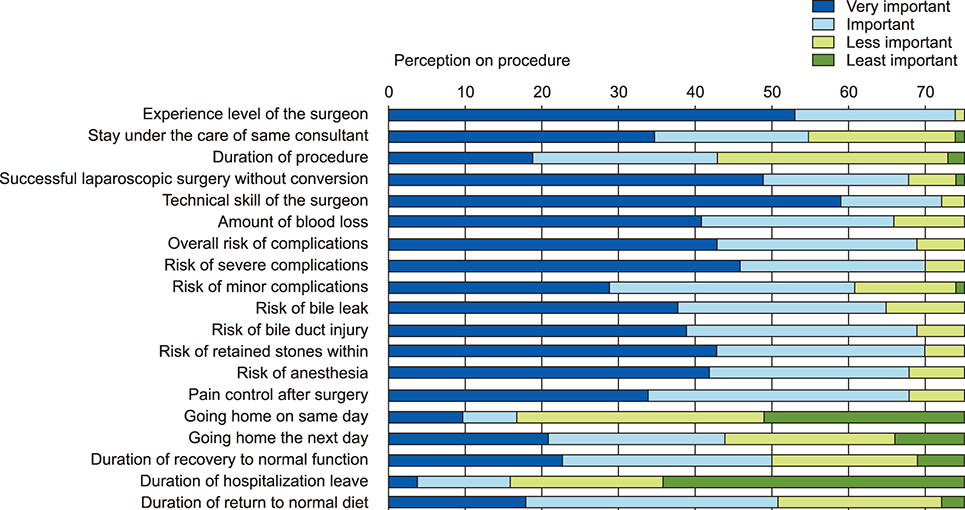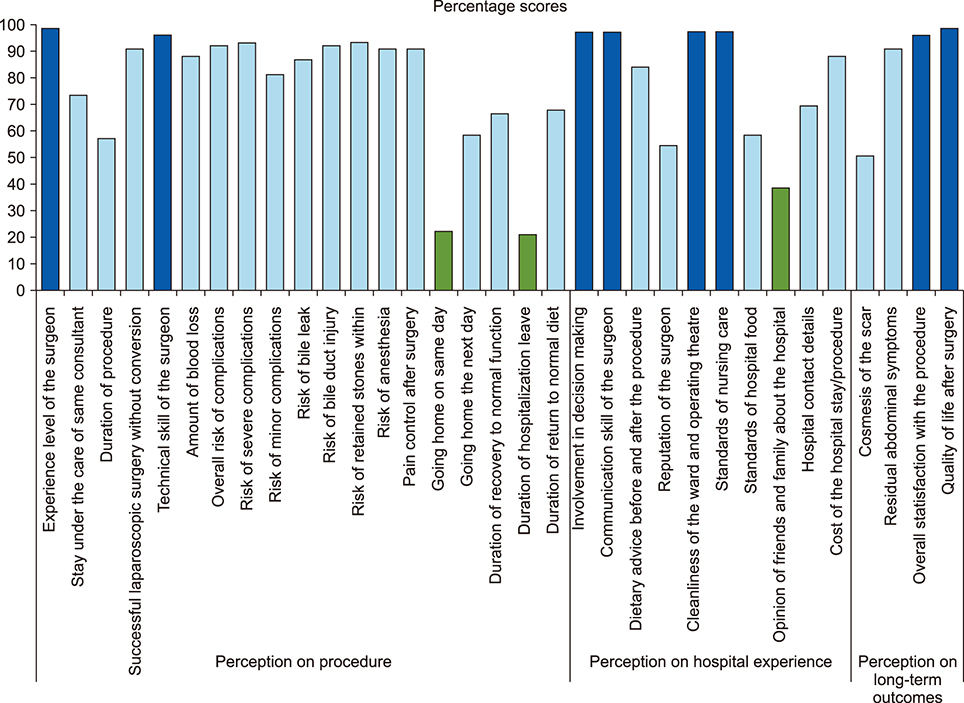Ann Hepatobiliary Pancreat Surg.
2019 Feb;23(1):20-33. 10.14701/ahbps.2019.23.1.20.
Patient reported outcomes in elective laparoscopic cholecystectomy
- Affiliations
-
- 1Department of General Surgery, Tan Tock Seng Hospital, Singapore. vishal_g_shelat@ttsh.com.sg
- 2School of Biological Sciences, Nanyang Technological University, Singapore.
- KMID: 2439042
- DOI: http://doi.org/10.14701/ahbps.2019.23.1.20
Abstract
- BACKGROUNDS/AIMS
Traditional outcome measures (e.g., length of hospital stay, morbidity, and mortality) are used to determine the quality of care, but these may not be most important to patients. It is unclear which outcomes matter to patients undergoing elective laparoscopic cholecystectomy (ELC). We aim to identify patient-reported outcome measures (PROM) which patients undergoing ELC valued most.
METHODS
A 45-item questionnaire with Four-point Likert-type questions developed from prior literature review, prospectively administered to patients treated with ELC at a tertiary institution in Singapore.
RESULTS
Seventy-five patients participated. Most essential factors were technical skill and experience level of a surgeon, long-term quality of life (QoL), patient involvement in decision-making, communication skill of a surgeon, cleanliness of the ward environment, and standards of nursing care. Least important factors were hospitalization leave duration, length of hospital stay, a family's opinion of the hospital, and scar cosmesis. Employed patients were more likely to find hospitalization leave duration (p < 0.001) and procedure duration (p=0.042) important. Younger patients (p=0.048) and female gender (p=0.003) were more likely to perceive scar cosmesis as important.
CONCLUSIONS
Patients undergoing ELC value long-term QoL, surgeon technical skill and experience level, patient involvement in decision-making, surgeon communication skill, cleanliness of the ward environment, and nursing care standards. Day-case surgery, medical leave, family opinion of hospital, and scar cosmesis were least important. Understanding what patients value will help guide patient-centric healthcare delivery.
MeSH Terms
Figure
Reference
-
1. Stinton LM, Shaffer EA. Epidemiology of gallbladder disease: cholelithiasis and cancer. Gut Liver. 2012; 6:172–187.
Article2. Friedman GD. Natural history of asymptomatic and symptomatic gallstones. Am J Surg. 1993; 165:399–404.3. Hassler KR, Jones MW. Gallbladder, cholecystectomy, laparoscopic. StatPearls. Treasure Island: StatPearls Publishing;2017.4. Harboe KM, Bardram L. The quality of cholecystectomy in Denmark: outcome and risk factors for 20,307 patients from the national database. Surg Endosc. 2011; 25:1630–1641.
Article5. Müller BP, Holzinger F, Leepin H, Klaiber C. Laparoscopic cholecystectomy: quality of care and benchmarking. Results of a single-institution specialized in laparoscopy compared with those of a nationwide study in Switzerland. Surg Endosc. 2003; 17:300–305.6. Zapf M, Denham W, Barrera E, Butt Z, Carbray J, Wang C, et al. Patient-centered outcomes after laparoscopic cholecystectomy. Surg Endosc. 2013; 27:4491–4498.
Article7. Lamberts MP, Den Oudsten BL, Gerritsen JJ, Roukema JA, Westert GP, Drenth JP, et al. Prospective multicentre cohort study of patient-reported outcomes after cholecystectomy for uncomplicated symptomatic cholecystolithiasis. Br J Surg. 2015; 102:1402–1409.8. Wanjura V, Sandblom G. How do quality-of-life and gastrointestinal symptoms differ between post-cholecystectomy patients and the background population? World J Surg. 2016; 40:81–88.
Article9. Yu H, Chan EE, Lingam P, Lee J, Woon WWL, Low JK, et al. Index admission laparoscopic cholecystectomy for acute cholecystitis restores Gastrointestinal Quality of Life Index (GIQLI) score. Ann Hepatobiliary Pancreat Surg. 2018; 22:58–65.
Article10. Wennmacker S, Lamberts M, Gerritsen J, Roukema JA, Westert G, Drenth J, et al. Consistency of patient-reported outcomes after cholecystectomy and their implications on current surgical practice: a prospective multicenter cohort study. Surg Endosc. 2017; 31:215–224.
Article11. McLean KA, Sheng Z, O'Neill S, Boyce K, Jones C, Wigmore SJ, et al. The influence of clinical and patient-reported outcomes on post-surgery satisfaction in cholecystectomy patients. World J Surg. 2017; 41:1752–1761.
Article12. Weldring T, Smith SM. Patient-Reported Outcomes (PROs) and Patient-Reported Outcome Measures (PROMs). Health Serv Insights. 2013; 6:61–68.13. Delvin NJ, Appleby J, Buxton M. Getting the most out of PROMs: putting health outcomes at the heart of NHS decision-making. London: King's Fund;2010.14. NHS Digital. Finalised Patient Reported Outcome Measures (PROMs) in England - April 2015 to March 2016 [Internet]. NHS Digital;2017. cited 2018 Jan 1. Available from: https://digital.nhs.uk/catalogue/PUB30036.15. Parkin E, Stott M, Brockbank J, Galloway S, Welch I, Macdonald A. Patient-reported outcomes for acute gallstone pathology. World J Surg. 2017; 41:1234–1238.
Article16. Ahmed S, de Souza NN, Qiao W, Kasai M, Keem LJ, Shelat VG. Quality of life in hepatocellular carcinoma patients treated with transarterial chemoembolization. HPB Surg. 2016; 2016:6120143.17. Ministry of Health (Singapore). National Health Survey 2010 [Internet]. Singapore: Ministry of Health (Singapore);2011. cited 2017 Dec 28. Available from: https://www.moh.gov.sg/content/moh_web/home/Publications/Reports/2011/national_health_survey2010.html.18. Dauser B, Görgei A, Stopfer J, Herbst F. Conventional laparoscopy vs. single port surgery from a patient's point of view: influence of demographics and body mass index. Wien Klin Wochenschr. 2012; 124:834–841.
Article19. Eypasch E, Williams JI, Wood-Dauphinee S, Ure BM, Schmülling C, Neugebauer E, et al. Gastrointestinal Quality of Life Index: development, validation and application of a new instrument. Br J Surg. 1995; 82:216–222.20. Sandblom G, Videhult P, Karlson BM, Wollert S, Ljungdahl M, Darkahi B, et al. Validation of Gastrointestinal Quality of Life Index in Swedish for assessing the impact of gallstones on health-related quality of life. Value Health. 2009; 12:181–184.
Article21. Korolija D, Sauerland S, Wood-Dauphinée S, Abbou CC, Eypasch E, Caballero MG, et al. Evaluation of quality of life after laparoscopic surgery: evidence-based guidelines of the European Association for Endoscopic Surgery. Surg Endosc. 2004; 18:879–897.
Article22. Jenkinson C, Coulter A, Bruster S. The Picker Patient Experience Questionnaire: development and validation using data from inpatient surveys in five countries. Int J Qual Health Care. 2002; 14:353–358.
Article23. Al-Abri R, Al-Balushi A. Patient satisfaction survey as a tool towards quality improvement. Oman Med J. 2014; 29:3–7.
Article24. Tattersall MH, Butow PN, Clayton JM. Insights from cancer patient communication research. Hematol Oncol Clin North Am. 2002; 16:731–743.
Article25. Goh LW, Lim AY. Surgical training in Singapore: will patients consent to trainee surgeons performing their operations? Ann Acad Med Singapore. 2007; 36:995–1002.26. Haueter R, Schütz T, Raptis DA, Clavien PA, Zuber M. Meta-analysis of single-port versus conventional laparoscopic cholecystectomy comparing body image and cosmesis. Br J Surg. 2017; 104:1141–1159.
Article27. Rosenmüller MH, Nilsson E, Lindberg F, Åberg SO, Haapamäki MM. Costs and quality of life of small-incision open cholecystectomy and laparoscopic cholecystectomy - an expertisebased randomised controlled trial. BMC Gastroenterol. 2017; 17:48.
Article28. Dancer SJ. Controlling hospital-acquired infection: focus on the role of the environment and new technologies for decontamination. Clin Microbiol Rev. 2014; 27:665–690.
Article29. Dancer SJ, White LF, Lamb J, Girvan EK, Robertson C. Measuring the effect of enhanced cleaning in a UK hospital: a prospective cross-over study. BMC Med. 2009; 7:28.
Article30. Edgcumbe DP. Patients' perceptions of hospital cleanliness are correlated with rates of meticillin-resistant Staphylococcus aureus bacteraemia. J Hosp Infect. 2009; 71:99–101.
Article31. Dubois CA, D'Amour D, Pomey MP, Girard F, Brault I. Conceptualizing performance of nursing care as a prerequisite for better measurement: a systematic and interpretive review. BMC Nurs. 2013; 12:7.
Article32. Harboe KM, Bardram L. Nationwide quality improvement of cholecystectomy: results from a national database. Int J Qual Health Care. 2011; 23:565–573.
Article33. Kow AW, Tan A, Chan SP, Lee SF, Chan CY, Liau KH, et al. An audit of ambulatory laparoscopic cholecystectomy in a Singapore institution: are we ready for day-case laparoscopic cholecystectomy? HPB (Oxford). 2008; 10:433–438.
Article34. Ahmad NZ, Byrnes G, Naqvi SA. A meta-analysis of ambulatory versus inpatient laparoscopic cholecystectomy. Surg Endosc. 2008; 22:1928–1934.
Article35. Gregori M, Miccini M, Biacchi D, de Schoutheete JC, Bonomo L, Manzelli A. Day case laparoscopic cholecystectomy: safety and feasibility in obese patients. Int J Surg. 2018; 49:22–26.
Article36. Tan CH, Pang TC, Woon WW, Low JK, Junnarkar SP. Analysis of actual healthcare costs of early versus interval cholecystectomy in acute cholecystitis. J Hepatobiliary Pancreat Sci. 2015; 22:237–243.
Article37. Sutton AJ, Vohra RS, Hollyman M, Marriott PJ, Buja A, Alderson D, et al. Cost-effectiveness of emergency versus delayed laparoscopic cholecystectomy for acute gallbladder pathology. Br J Surg. 2017; 104:98–107.38. Amirthalingam V, Low JK, Woon W, Shelat V. Tokyo Guidelines 2013 may be too restrictive and patients with moderate and severe acute cholecystitis can be managed by early cholecystectomy too. Surg Endosc. 2017; 31:2892–2900.
Article39. Lozano LM, García-Cueto E, Muñiz J. Effect of the number of response categories on the reliability and validity of rating scales. Methodology. 2008; 4:73–79.
Article
- Full Text Links
- Actions
-
Cited
- CITED
-
- Close
- Share
- Similar articles
-
- Comparison of Laparoscopic Cholecystectomy and Minilaparotomy Cholecystectomy
- Laparoscopic Cholecystectomy in the Second Trimester of Pregnancy
- Korea University Experience in Laparoscopic Cholecystectomy
- A Clinical Analysis of 300 Case of Laparoscopic Cholecystectomy
- Chinical Comparison of the Traditional Versus Laparoscopic Surgery in Cholecystectomy for Cholelithiasis






